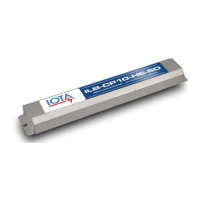ILBLP CP HE SD
“B” MOUNTING STYLE
CONSTANT POWER
EMERGENCY LIGHTING EQUIPMENT
FOR LED
(800) 866-4682 • www.iotaengineering.com
LED CLASS 2
INSTRUCTION MANUAL
HIGH EFFICIENCY PERFORMANCE
MEETS CA T20 BATTERY CHARGER
EFFICIENCY STANDARDS
IMPORTANT SAFEGUARDS
When using electrical equipment, basic safety precautions should always be followed, including the following:
READ AND FOLLOW ALL SAFETY INSTRUCTIONS
1. CAUTION – The TBTS Test Button Component serves as the unit connector. The ILBLP CP HE SD will initi-
ate once both the TBTS until installation is complete and A.C. power is supplied to the unit.
2. CAUTION – This xture provides more than one power supply output source. To reduce the risk of electrical
shock, disconnect both normal and emergency sources by turning o the A.C. branch circuit and by discon-
necting the TBTS Test Button Component before servicing.
3. CAUTION – This equipment provides reduced current levels when higher voltage loads are connected. Load
calibration is required to ensure proper operation (see page 4).
4. CAUTION – This is a sealed unit. Components are not replaceable. Replace the entire unit when necessary.
5. CAUTION – Installation and servicing should be performed by qualied personnel only. De-energize before
opening.
6. The ILBLP CP HE SD is for use with grounded LED luminaires listed to UL standards. Not for use in heated
air outlets or hazardous locations.
7. The ILBLP CP HE SD and A.C. driver must be on the same branch circuit.
8. Do not mount near gas or electric heaters.
9. The ILBLP CP HE SD should be mounted in locations and at heights where it will not readily be subjected to
tampering by unauthorized personnel.
10. Product output voltage varies according to wattage. Refer to Illustration 1 for output voltage per model.
11. The ILBLP CP HE SD is certied in the CA Title 20 Modernized Appliance Eciency Database System (MAED-
BS) as a small battery charger.
12. Suitable for use in damp locations.
13. For use in 0° C minimum, 55° C maximum ambient temperatures.
14. The use of accessory equipment not recommended by the manufacturer may cause an unsafe condition, void
warranty, and result in non-compliance with UL specications.
15. Do not use this equipment for other than intended use.
16. Install in accordance with the National Electrical Code and local regulations.
17. Lighting xture manufacturers, electricians, and end-users need to ensure product system compatibility before
nal installation. See addendum for compatibility and covered luminaire requirements.
SAVE THESE INSTRUCTIONS

